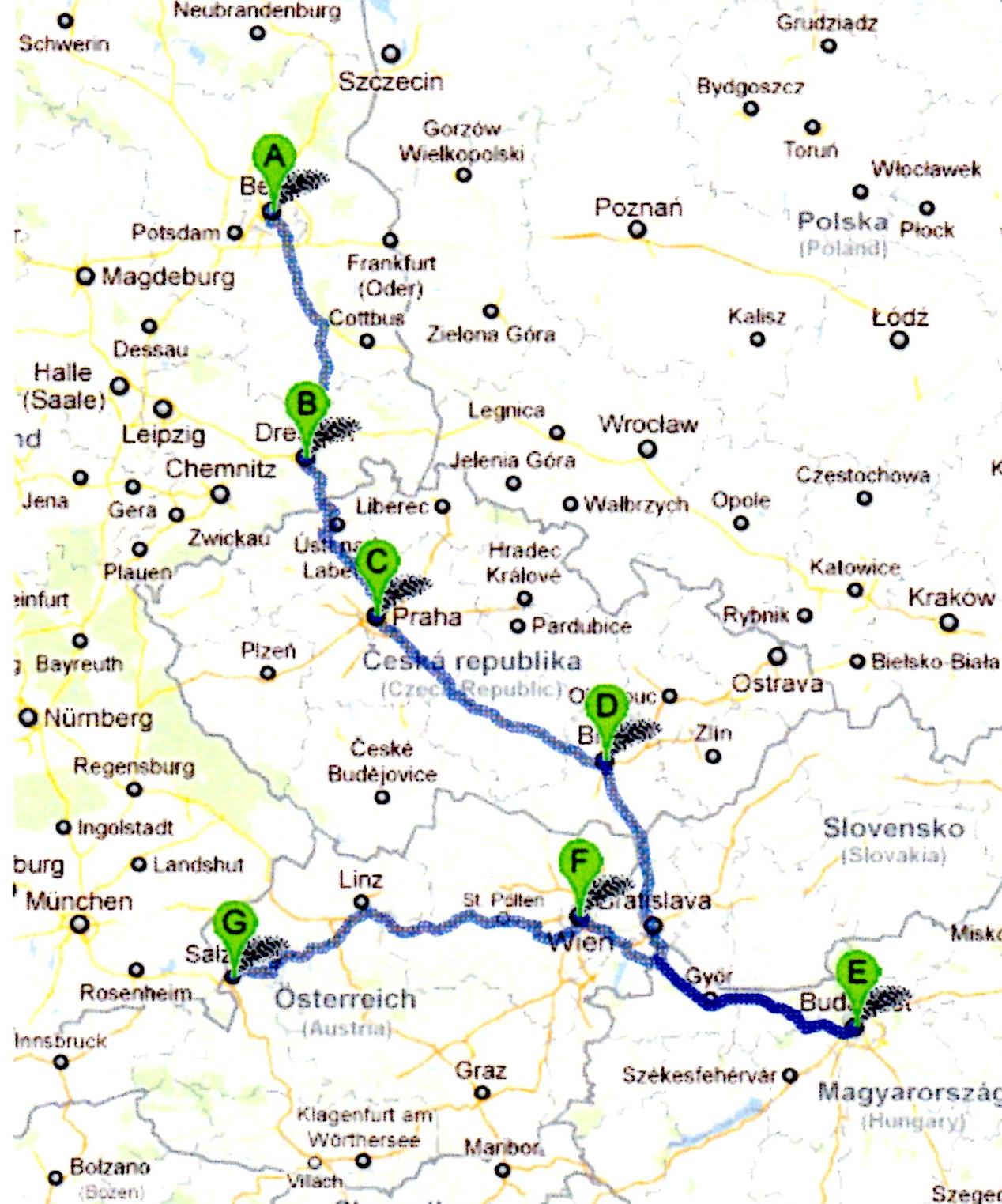CENTRAL EUROPE 2011
Day 7
September 8
Thursday
DRESDEN
We got up early, it was cold and rainy.
We looked in the hotel dining room but the breakfast buffet didn’t
appeal to us – a lot of fruits, shrimp salad, potato salad and other items
that we didn’t care to eat for breakfast.
Also it was rather expensive. We walked a block to the main street and
stopped at Schaefer’s Bakery for breakfast pastries and coffee.
It hit the spot.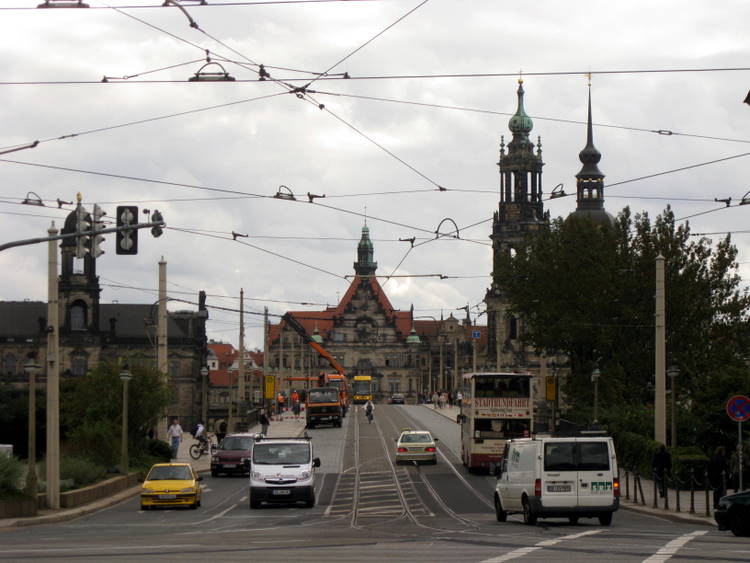
When came outside, it was raining rather steadily.
We walked across the bridge to Royal Palace and the Green Vault where we
had a 10:00 appointment. They only
allow 100 people an hour into the rooms. It
is rather difficult to get timely tickets. We
made reservations on- line many months in advance.
THE
ROYAL PALACE AND GREEN VAULT
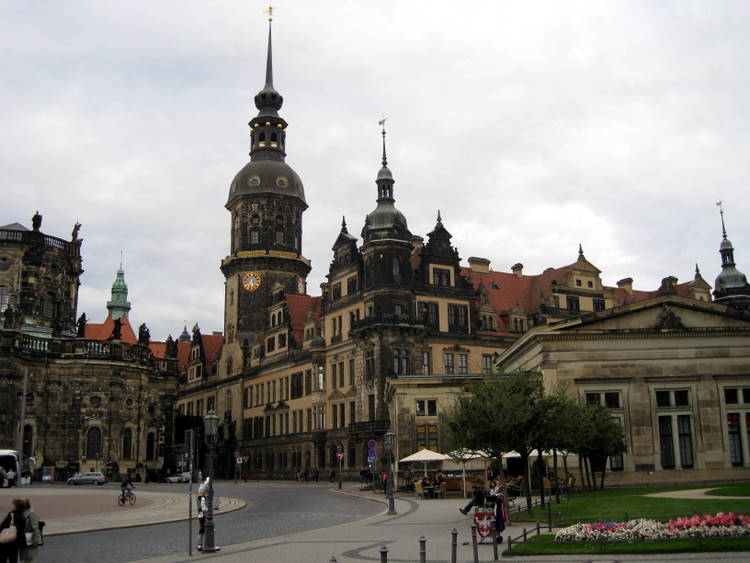
This Renaissance palace was once the residence of
the Saxon prince elector, Augustus the Strong.
The history of the
"Green Vault" goes back to the year 1547, when elector Moritz of
Saxony initiated the building of an additional west wing to the palace. Four of
the resulting rooms were given elaborate, molded plaster ceilings. The column
bases, walls and capitals were painted with a characteristic, bluish-green
paint. Due to this color, the rooms were soon known as the "Green
Vault", and the name remains to this day.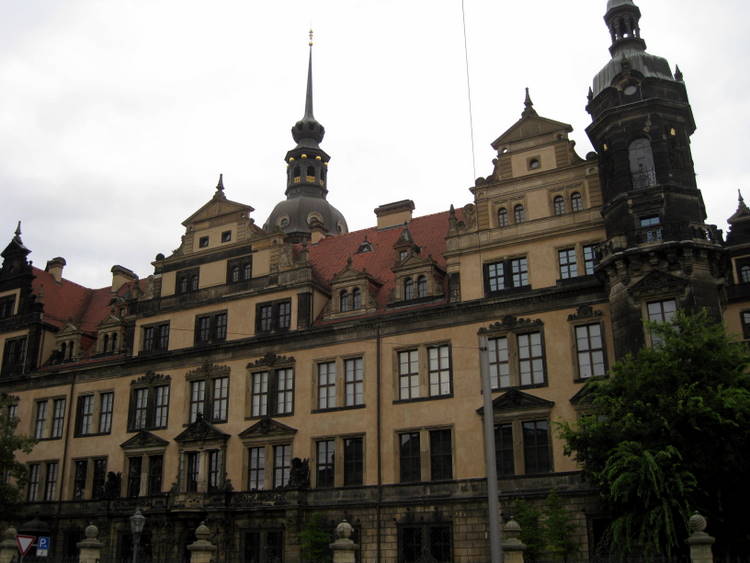
Throughout the 17th century, these rooms were used as a secret treasure
chamber for important documents and jewelry of the Saxon monarchs. Between 1723
and 1729, Augustus the Strong, turned the once secret chambers into a public
museum. First, he ordered the construction of splendid rooms to display his
collection. A suite of eight interconnecting rooms whose architectural beauty
blended with the abundance and quality of the priceless treasures were
constructed. Augustus the Strong could now exhibit his entire collection of
valuables, including works of silver and goldsmith art, bronze statues, amber
and ivory. These rooms were unchanged for almost two centuries. When war was
imminent in 1938, the art treasures were taken to the Konigstein Fortress.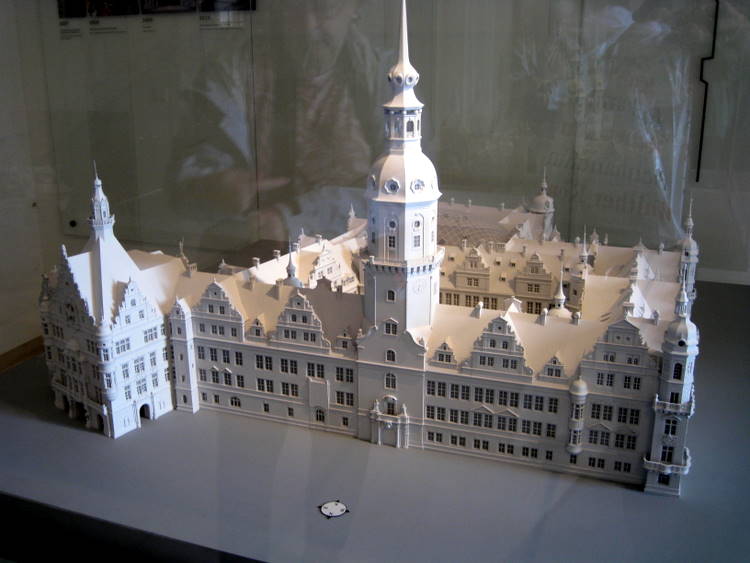
The Green Vault was severely damaged in the February 13, 1945 bombing of
Dresden. Three of the eight rooms were totally destroyed. At
the end of the war in 1945, the treasures were confiscated by the Red Army and
transported to the Soviet Union. After their return to Dresden in 1958, part of
the collection was displayed at the Albertinum. In 2006, the Historic Green
Vault was reopened in the magnificent suite of rooms as it existed in 1733 at
the time of its founder's death.
There were nine rooms filled with all kinds of
beautiful works of art. Security was
very tight in that objects were not in glass cases but on stands or mounted of
beautiful little bracket shelves, generally attached to walls of mirrors.
We had audio phones which explained most of the exhibits.
It was a wonderful experience to see these magnificent works of art.
The tour lasted about an hour.
There are several other exhibits in the Palace
–the New Green Vault and the Watchman’s Tower.
We only had tickets for th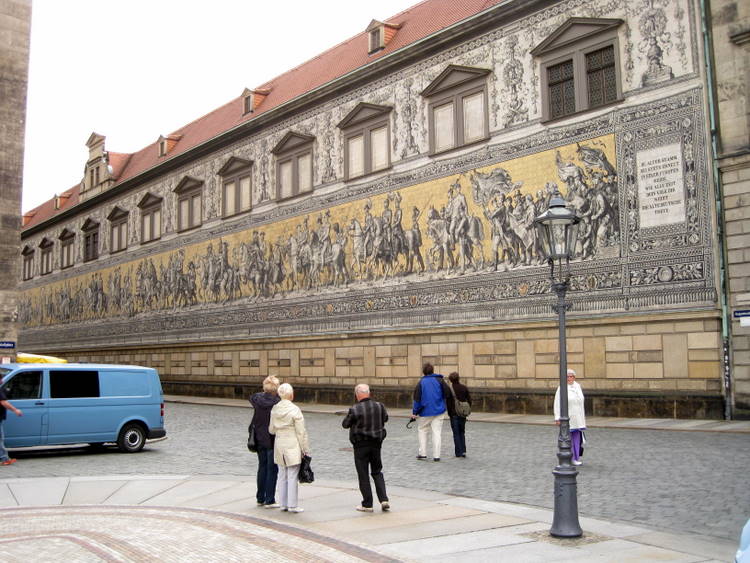 e
Historic Green Vault. The Palace had
a very large book and gift store.
e
Historic Green Vault. The Palace had
a very large book and gift store. 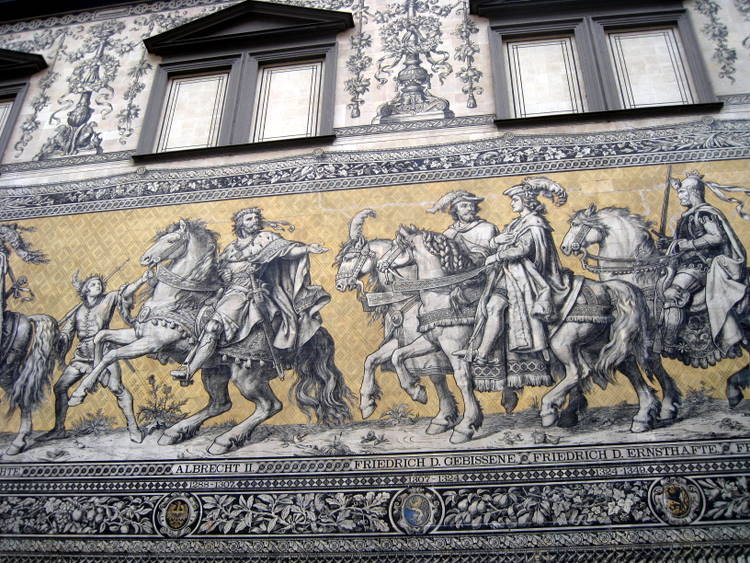
They
had the models of the Frauenkirche and the Semperoper, both of which I had. I
did buy a model kit of a medieval village.
We started back towards the Frauenkirche and passed
the Parade of Nobles again on the
way. This is a mural which is
painted on 24,000 Meissen porcelain titles.
It is longer than a football field and illustrates 700 years of Saxon
royalty. It is a careful study of
the evolution of weapons and fashions over the years.
It was a wonderful exhibit.
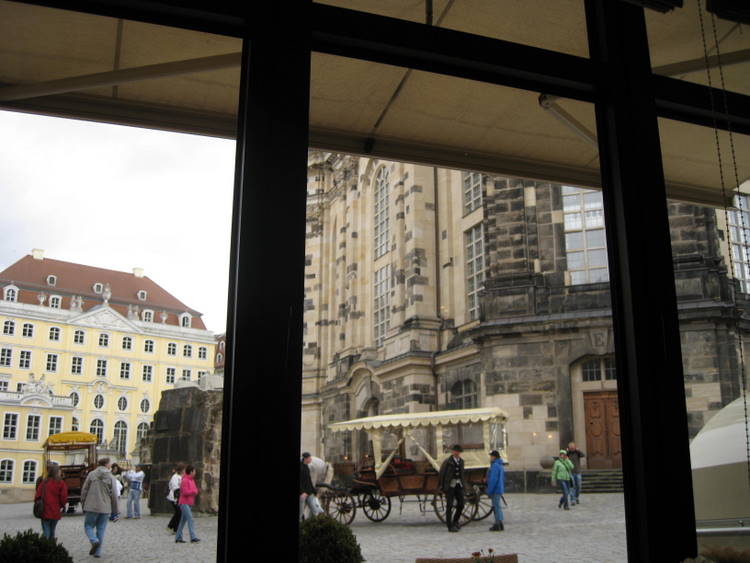 We were hungry
by
that time and went to the Hilton Bistro which was located across
We were hungry
by
that time and went to the Hilton Bistro which was located across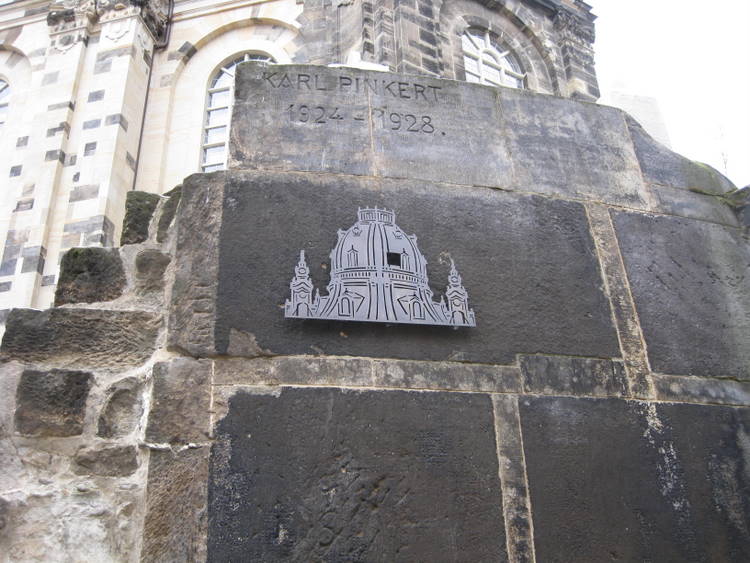 from the back side of the Frauenkirche. For
our table we had a view of part of a wall that was destroyed during the war and
left as a memorial. For lunch I had
a hamburger and FF and my wife had a made croque madame sandwich.
from the back side of the Frauenkirche. For
our table we had a view of part of a wall that was destroyed during the war and
left as a memorial. For lunch I had
a hamburger and FF and my wife had a made croque madame sandwich.
We walked further past the back of Frauenkirche,
stopping briefly in Albertinum museum where the Frauenkirche bookstore was
located. This restored building
houses a number of statuary exhibits.
It was
located next to a set of steps leading to the B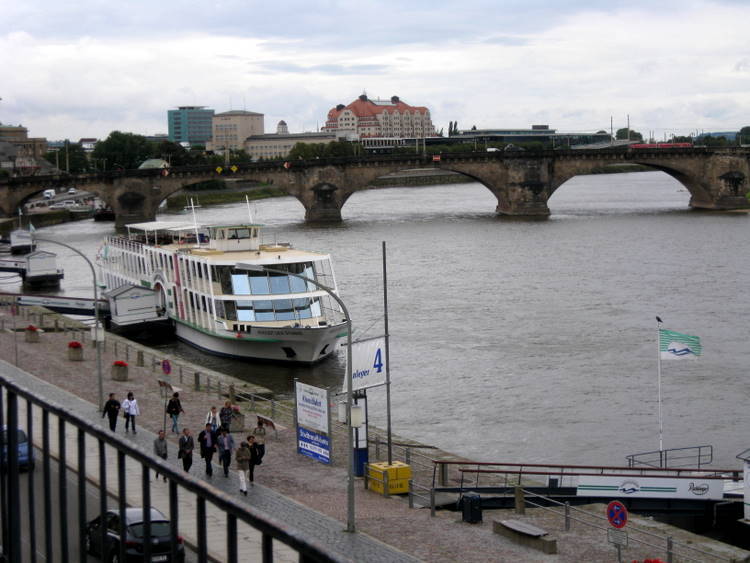 ruhische
Terrasse – also called the balcony of Europe.
Even though it w
ruhische
Terrasse – also called the balcony of Europe.
Even though it w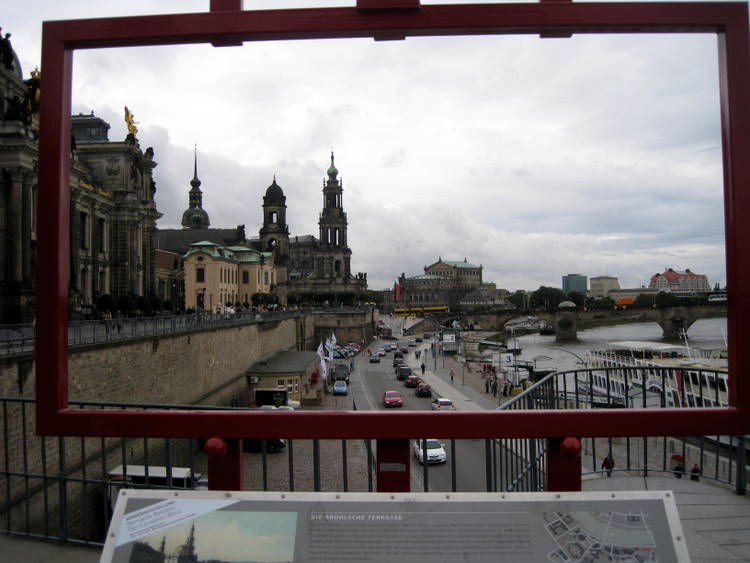 as
cloudy and drizzly, it was beautiful, and we walked along this terrace
overlooking the river. There
was one spot where there was a metal frame. When you stood in front of it and
looked though it, you could see subject of the famous Canaletto painting – The
Balcony of Europe. We came down the
steps to the area in front of the Roman Catholic Church, the Hofkirche.
as
cloudy and drizzly, it was beautiful, and we walked along this terrace
overlooking the river. There
was one spot where there was a metal frame. When you stood in front of it and
looked though it, you could see subject of the famous Canaletto painting – The
Balcony of Europe. We came down the
steps to the area in front of the Roman Catholic Church, the Hofkirche.
In order to gain the Polish crown, August the
Strong, the Elector of Saxony, converted to the Catholic faith.
After his death,
August’s son, Friedrich August II (1696-1763) and his wife, Maria Josepha, who
was the daughter of Emperor Joseph I, conceived of a plan to build a prestigious
court church. The Italian master
builder Gaetano Chiaveri was appointed architect for the project.
In 1739, workers laid the cornerstone of the Church.
Although initial progress was good, construction of the Court Church
slowed to a halt. As the royal
family’s interest in the project ebbed, so did the flow of funds needed for
completion of the church. Deeply
offended by the court’s lack of commitment, Chiaveri left Dresden in 1748.
Using Chiaveri’s plans other builders competed the church in 1751.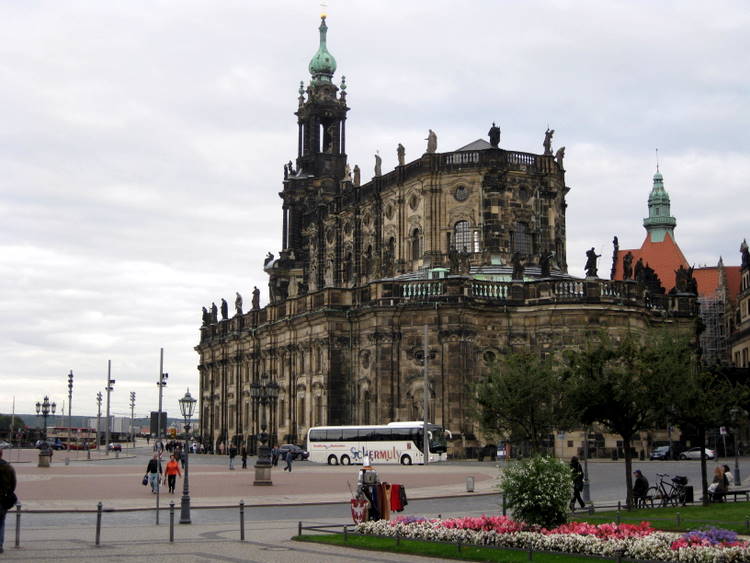
The Hofkirche was badly damaged during the allied
air raids on Dresden in February of 1945. Bombs fell through the roof of the
nave, causing it to collapse. And the interior was extensively burnt during the
raids. Reconstruction of the church began soon after the end of the war, but
progress was slow. By 1955, a shell of the exterior was completed and, in 1962,
a reconstructed nave was used once again for religious services. Finally, in
1987 reconstruction of the entire structure was finished. Many damaged,valuable
interior features of the church were saved and restored, including the
Silbermann organ which was returned to its home in the Hofkirche.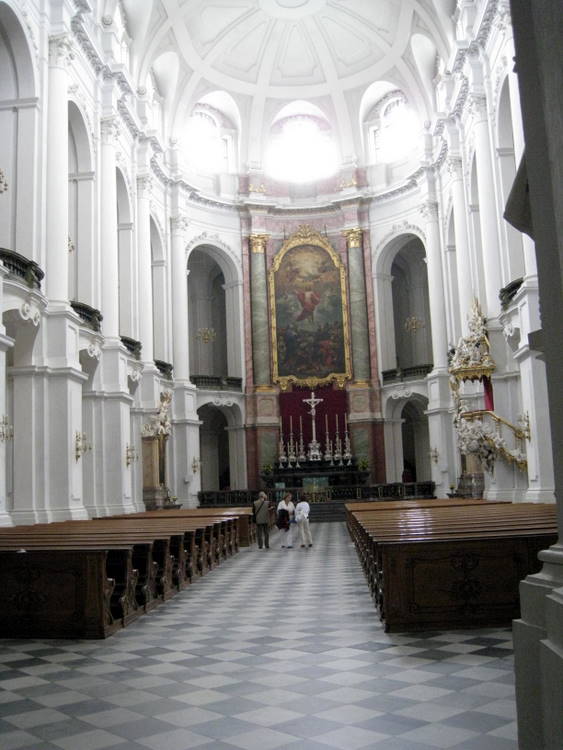
In the High Baroque style, the church is oval
shaped with an impressive belfry measuring 272 feet in height. Balustrades frame
the church and from these features arise 78 statues, each measuring almost 1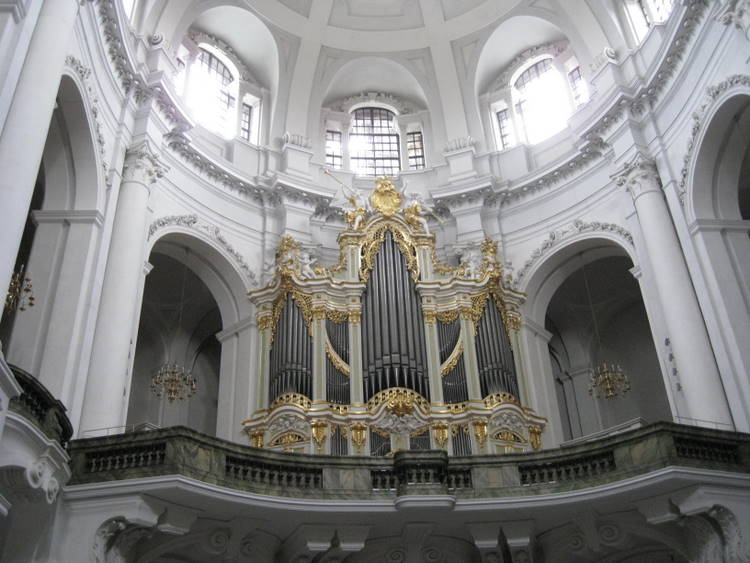 0
feet high. The statues represent historical and religious figures.
0
feet high. The statues represent historical and religious figures.
We visited the interior where we were allowed to
take pictures. The nave is
surrounded by a two story arcade of pillars.
Two broad aisles adjoin the nave. There
was a chapel at each of the church’s four corners.
The high altar is made of local marble. In the center was a large
painting of the Ascension.
One
chapel, the Memorial Chapel, had very modern artwork. It is dedicated to those
who died in the WWII bombing and to all victims of violence.
The pieta altarpiece was made in 1973 of Meissen porcelain.
The tall vertical stone represents Mary – note
the two eyes at the very top. Half way down Mary offers a crown of thorns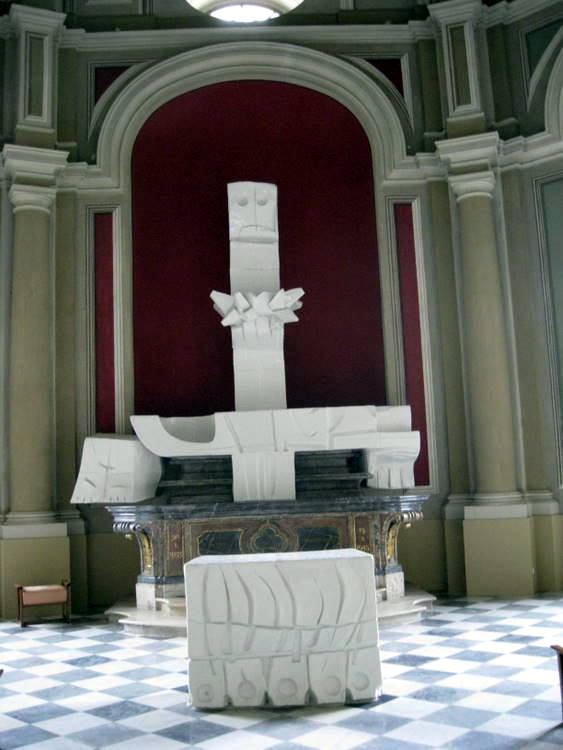 made from Dresden rubble. Jesus in
her lap is represented by the horizontal slab.
The freestanding altar in front shows five flaming heads which symbolize
how the citizens of Dresden suffered. On
either side of the main altar 30-1-33 and 13-2-45 which mark the period between
Hitler’s rise to power and the night that Dresden was destroyed.
made from Dresden rubble. Jesus in
her lap is represented by the horizontal slab.
The freestanding altar in front shows five flaming heads which symbolize
how the citizens of Dresden suffered. On
either side of the main altar 30-1-33 and 13-2-45 which mark the period between
Hitler’s rise to power and the night that Dresden was destroyed.
When we
came out it was still raining but we decided that want to go see the Kreuzkirche
church (Church of the Holy Cross), which was several books away.
The
Kreuzkirche has a history of being destroyed and rebuilt. In the early 15th
century the old 13th century church was replaced by a gothic building, but it
burned down in 1492. In the rebuilt church the first Lutheran service in Dresden
was held in 1539. Between 1579 and 1584 a new tower was constructed, 295 feet
high. Bombardments of the Prussian army in 1760 heavily damaged the Kreuzkirche.
Its tower seemed unharmed, but collapsed five years later during reconstruction
work. The church was rebuilt once again between 1764 and 1792 after a
neoclassicist design by Johann Georg Schmidt.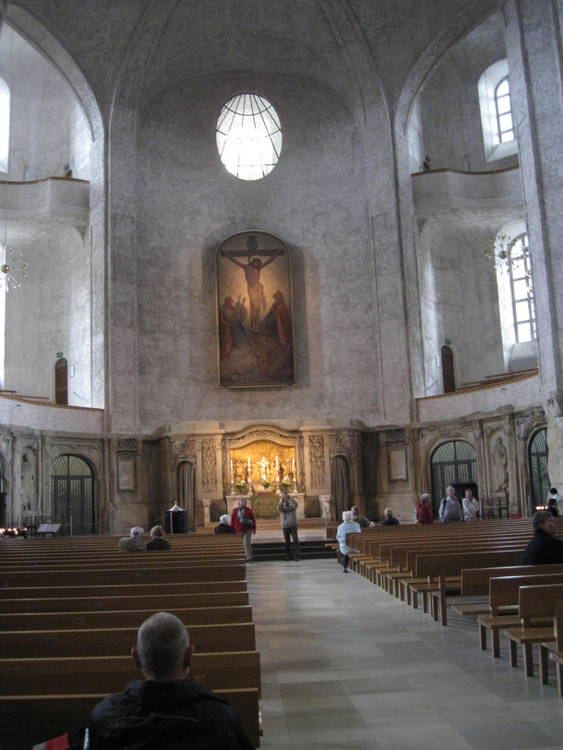
Disaster
struck again in February 1945 when the Kreuzkirche was one of the many buildings
that were damaged by fire bombardments. Reconstruction of the exterior started
soon after the war, in 1946, and was completed in 1955.
The
church, although on a corner, was difficult to photograph.
The interior was somewhat stark.
During the bombing, fire destroyed the interior. After the war the
decision was made to not restore the interior in original style. Instead the
plan was to show the scars of the war - a raw plaster covers the walls
and huge pillars, the few remaining sandstone embossments were left damaged,
only the lower parts of the altar are intact. Miraculously the altar painting
survived the fire, only the colors darkened.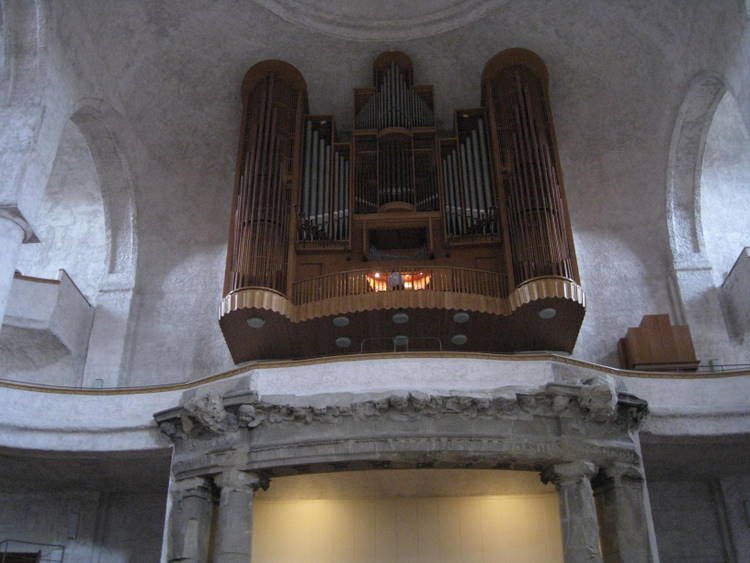
Kreuzkirche is famous for his fine organ and music.
There was a fifteen minute organ concert at 3:00. We
decided not to stay because we wanted time to rest before dinner and the opera.
When we went out it was pouring hard, so we went back in for the concert.
They church was almost filled. The
organ is famous. The first selection
was by Bach. A man dressed in a
sports shirt and blue jeans stepped into the pulpit and read some scripture in
German. Then the organist played an
arrangement of “Now thank we all our God”
The rain had slackened up a little when we came out, so we walked back to
our hotel.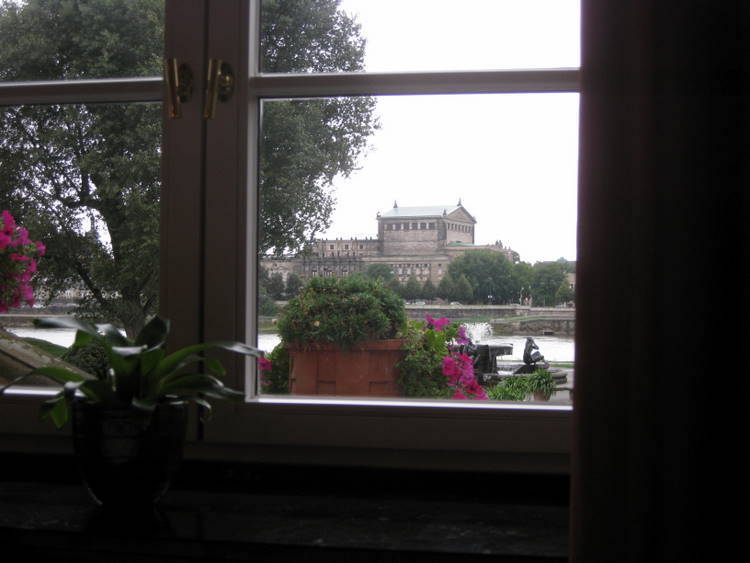
We went to the Canaletto restaurant in the Westin
Bellvue for dinner. Since they
hadn’t received our reservation from Bookatable for the night before, they had
told us to come at 5:00 for a pre-opera dinner with dessert afterwards.
We were surprised that we were the only people there.
They welcomed us like royalty. They
did admit that they had found our reservation, and had forgotten that we were
coming since they were so busy
planning the private party. We were seated at a nice table sprinkled with little
fake jewels and little red hearts with a view of the river and the Semperoper
(the opera house). Our server, who
had made the arrangements the night before, brought us some champagne in a
little container that held two flutes with pointed bottoms. The menu had
excellent choices. For a
starter my wife had a quiche with
small slices of chicken on the side. I
had a delicious pumpkin soup with a fried shrimp on the side.
For the main course I had chicken livers, figs and mushrooms served over
noodles with a sherry sauce. My wife
had red mullet served over pumpkin risotto.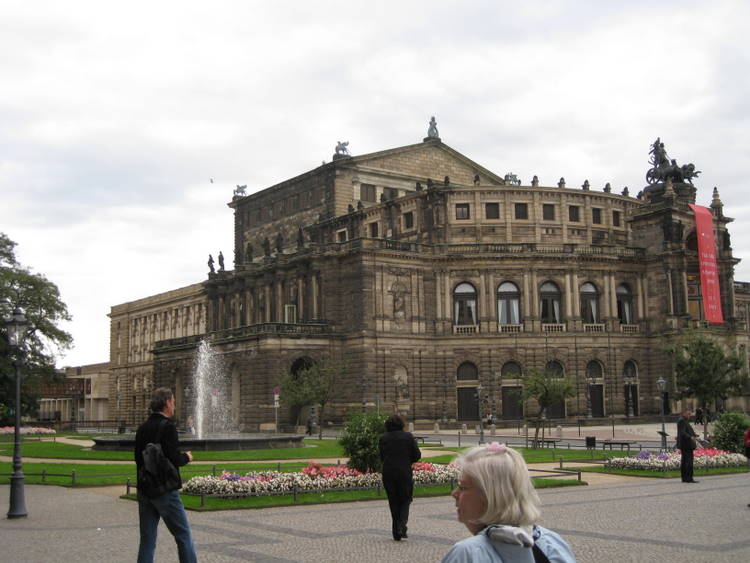
We had time to walk back across the bridge to the
Semperoper. As in past travels, when
we know that we are going to a concert, play or going to eat at fancy
restaurants, I wear my blue blazer on the plane.
On almost all of our trips, we have rented a car so it is easy to carry
the blazer. Since we are traveling on the train on this trip, I just wear it on the train rather than get wrinkled
in a suitcase. Since it was cold out
I wore my red sweater over my shirt and tie and then my blazer.
We carried a small umbrella, but the wind was blowing very hard.
So my blazer was a little damp when we got to the opera house.
After we got in I stepped out into a hall and removed my sweater as I was
too warm. About 95 % of the men had
on coats and ties.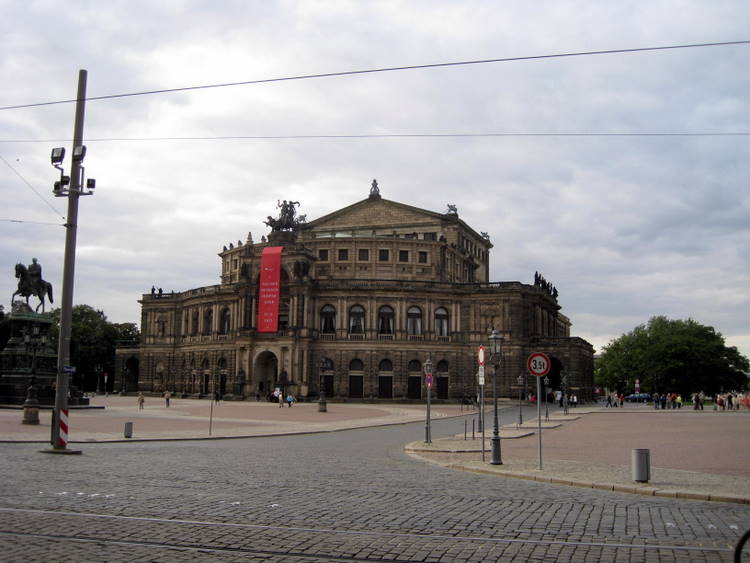
THE SEMPEROPER
The Saxon State Opera House is nicknamed the
Semperoper after its architect Gottfried
Semper. Three opera houses have
stood on this spot. The first was
destroyed by fire in 1869, the second during WWII in 1945.
It is rebuilt much in the same type as the first one using several
different architectural styles.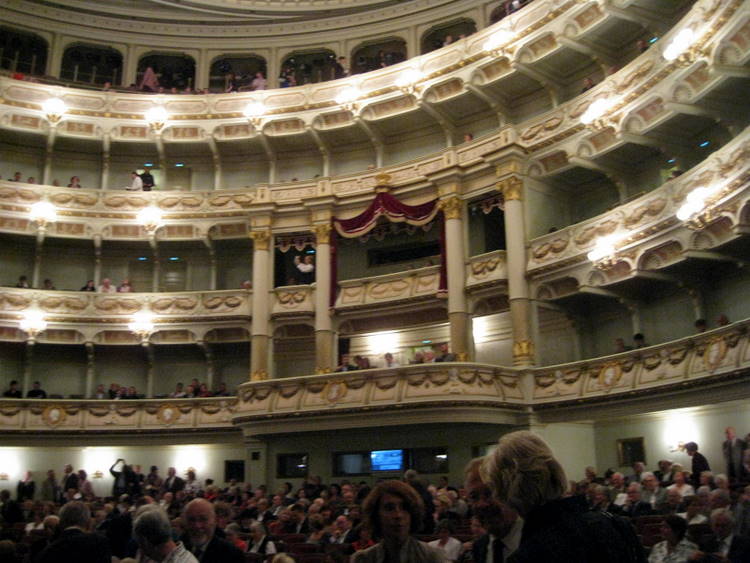
We had wanted to attend the opera in Dresden so in
May we booked tickets to the Marriage of Figaro.
We had two end seats on the second row.
It wasn’t too close to the stage. The
set was very modern and somewhat sparse. The
opera was sung in Italian and the subtitles (translation projected above the
stage were in German, so we were out of luck on both counts.)
We had brought a summary from a recent Teaching Company catalog but had
forgotten to refresh our minds of the story.
The opera was well done and we could get the jest of what was going on.
There was an intermission, and we wand ered
around a little. The interior was
beautiful in its Baroque theme. The opera began at 7:00 and over about 10:15.
There were a number of curtain calls and the applause lasted a long time.
No one left early as we often see at the Kennedy Center.
No one stood for the applause either.
ered
around a little. The interior was
beautiful in its Baroque theme. The opera began at 7:00 and over about 10:15.
There were a number of curtain calls and the applause lasted a long time.
No one left early as we often see at the Kennedy Center.
No one stood for the applause either.
I was able to get my sweater on under my blazer.
It was still raining. We
walked to the Canaletto in the Westin Bellevue for dessert. Again we were the
only people in the restaurant. We
were tired and wet, but the same hostess insisted that we stay and have our
dessert. There were two choices on
the menu so we had one of each. One
was two little dumplings with a sour cream ice cream. They
other was a beautiful dish of assorted fruit.
We got the bill. We thought
that we might have received a free meal or at least a discount for their booking
mistake but they had charged us for everything except the champagne. It
was worth it.
By then it was about midnight as we walked back to
our hotel.



 e
Historic Green Vault. The Palace had
a very large book and gift store.
e
Historic Green Vault. The Palace had
a very large book and gift store. 
 We were hungry
by
that time and went to the Hilton Bistro which was located across
We were hungry
by
that time and went to the Hilton Bistro which was located across from the back side of the Frauenkirche. For
our table we had a view of part of a wall that was destroyed during the war and
left as a memorial. For lunch I had
a hamburger and FF and my wife had a made croque madame sandwich.
from the back side of the Frauenkirche. For
our table we had a view of part of a wall that was destroyed during the war and
left as a memorial. For lunch I had
a hamburger and FF and my wife had a made croque madame sandwich. ruhische
Terrasse – also called the balcony of Europe.
Even though it w
ruhische
Terrasse – also called the balcony of Europe.
Even though it w as
cloudy and drizzly, it was beautiful, and we walked along this terrace
overlooking the river. There
was one spot where there was a metal frame. When you stood in front of it and
looked though it, you could see subject of the famous Canaletto painting – The
Balcony of Europe. We came down the
steps to the area in front of the Roman Catholic Church, the Hofkirche.
as
cloudy and drizzly, it was beautiful, and we walked along this terrace
overlooking the river. There
was one spot where there was a metal frame. When you stood in front of it and
looked though it, you could see subject of the famous Canaletto painting – The
Balcony of Europe. We came down the
steps to the area in front of the Roman Catholic Church, the Hofkirche.

 0
feet high. The statues represent historical and religious figures.
0
feet high. The statues represent historical and religious figures.

 made from Dresden rubble.
made from Dresden rubble.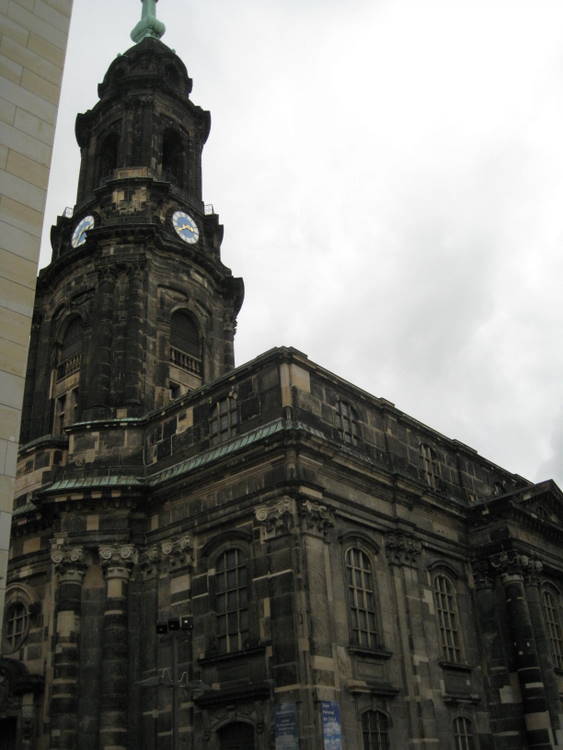






 ered
around a little.
ered
around a little.